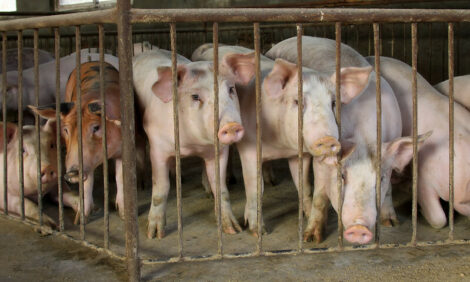



Heat stress: It’s not just for market hogs
Losses due to heat stress are commonly associated with market hogs, particularly during transportation in the hot, humid summer months, but recent research shows that weaners and feeder pigs are adversely affected as well.Heat stress is the result of an increase in temperature and relative humidity and its effect on a pig’s internal body temperature. Pigs are especially sensitive to heat stress due to their lack of sweat glands and must rely on open-mouth breathing and heat dissipation on the skin’s surface to cool themselves.
Sorting and loading pigs even in relatively mild temperatures of 70° F (21° C) can result in heat-stressed animals (see chart). Signs that animals are experiencing heat stress during handling include excessive panting, squealing and difficulty in herding.

Don’t forget the weaners and feeder pigs
While there is a wealth of data on finishing pigs and transportion, very little is known about the effect on weaned and feeder pigs even though today’s swine-production systems rely on separation of farrowing, nursery and finishing systems.
A recent research study, conducted at Iowa State University and funded by the National Pork Board and Iowa Pork Producers, looked at the effect of transportation on weaned and feeder pigs.2 Mortality rates were affected by pig type, ambient temperature and travel distance.
The study found that weaned pigs had higher mortality rates than feeder pigs, especially under warm/hot conditions (temperatures greater than 77° F or 25° C).
In fact, mortality rates for weaned pigs transported at temperatures greater than 77° F (25° C) were three times that of weaned pigs transported at temperatures less than 59° F (15° C). Surprisingly, the mortality rate of weaned pigs was approximately twice that of feeder pigs in the warm/hot category.
The combination of high temperature and long travel distance yielded the highest levels of mortality.
“This research has helped shape the picture of transport temperature needs for weaned and feeder pigs,” says Sherrie Webb, director, animal welfare for the National Pork Board. “It continues to be a research priority.”
Overheating at the meat processing facility
Communication and designated loading and unloading times must be followed to avoid long wait times at processing facilities while minimizing the amount of time pigs must be on the trailer. Individual plants have limitations on how long trailers can wait in line before unloading.
In order to avoid long wait times during the hottest part of the day, many processing plants and livestock haulers are willing to reschedule loads to help prevent heat stress during the summer months.
If you are facing an extended wait time, contact plant personnel for guidance on how to keep pigs cool. Animal welfare is a top concern for them as well.
Transportation safety tips
By carefully watching forecasted temperature and weather conditions, pork producers can take steps to minimize heat stress during transport, especially when temperatures and humidity levels reach the danger and emergency zones.
These steps include:
- Opening nose vents, ventilation holes and slots in trailers
- Reducing loading density by 10% to 20% (i.e., allowing 300-pound pigs 5.0 square feet of floor space)
- Scheduling transportation for early morning or late night
- Loading and unloading promptly
- Wetting pigs for 5 to 10 minutes during or after loading at temperatures over 80° F (27° C)
- Using a large droplet spray, not a mist
- Avoid overwetting to help prevent runoff or excess humidity buildup
- Avoid pouring large amounts of water on overheated pigs
- Allowing pigs to dry before wetting again
- Maintaining air movement through truck motion, crosswinds or fan banks
- According to Webb, one of the most important factors in avoiding heat stress is that all loads — regardless of pig size — are scheduled and that everyone at the loading and unloading sites is aware of the scheduled times.
1 Transport Quality Assurance Version 6 Handbook. National Pork Board. Located at http://d3fns0a45gcg1a.cloudfront.net/sites/all/files/documents/TQA/2017-Version6/TQA.V6_Handbook.pdf . Accessed May 11, 2017.
2 Zhao Y, Xin H, Harmon JD, Bass TJ. Mortality Rate of Weaned and Feeder Pigs as Affected by Ground Transportation Conditions. Am Soc Agricul Biolog Eng. 2016;59(4):943-948.






